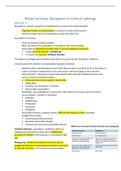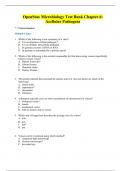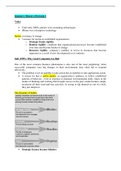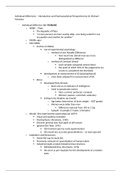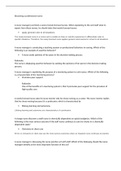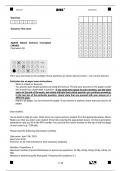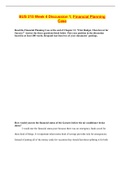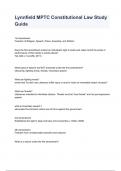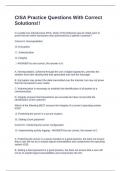Lecture 1:
Deception in animals: deception is fundamental to survival in the animal kingdom
- Feigning of death to avoid predators is common in many animal species
- Adult birds feign injury to draw predators away from their nest
Assumption of honesty:
- Clinicians trained to believe patients
- Often not aware of the potential for deception in the clinical settings
- Some patients deliberately produce false or grossly exaggerate symptoms
To gain external incentive (malingering)
To assume the sick role (factitious disorder)
The behavior (malingering and factitious disorder) is the same but the motivation is different.
Common psychiatric disorder accompanied by deceptive behavior;
- Substance abuse and dependence; part of the disease; denial and other forms of deception in
order to minimize consequences of use and ensure continued supply of the substance
- Eating disorders; clinicians are aware that patients with anorexia and bulimia nervosa use
various common deceptive practices
Dishonesty about body weight or food intake
Hiding food
Secretive use of laxatives or diuretics
Body weight manipulation
- Paraphilias; sexual deviations or perversions with behaviors or sexual urges focusing on
unusual objects, activities or situations
Fetishism
Exhibitionism
Frotteurism
Voyeurism
Pedophilia
- Personality disorders; common feature: difficulty with impulse control, including
exaggeration or lying
Antisocial personality disorder
Borderline personality disorder
Histrionic and narcissistic personality disorder
Factitious disorder; a psychiatric condition in which an
individual presents with an illness that is deliberately
produced or falsified for the purpose of assuming the sick
role.
Malingering; intentional production of false or grossly
exaggerated physical or psychological symptoms motivated
by external incentives, such as financial compensations.
,Differentiation:
- Factitious disorder or malingering
- Real medical or mental condition
(other than factitious disorder)
Somatic symptom and related disorder;
- Prominence of somatic symptoms
associated with significant distress and impairment
- Different forms (e.g. conversion disorder and illness anxiety disorder)
- Illness anxiety disorder; preoccupation with fears of having a serious illness
- Conversion disorder; sensory or motor symptoms without any physiological cause
Determining existence of an external incentive can be difficult (malingerers usually do not trumped
their external incentives).
Voluntariness and intentionality are more likely dimensions rather than discrete entities.
Clinicians:
- No monopoly on distortion for patients
- It is estimated that around 30% of all sick notes are bogus
- Physicians are prepared to lie in the interest of their patients (e.g. to secure insurance
payment)
Placebo is deception but can be in your favor.
Lecture 2: Factitious disorders
Factitious disorder (FD); refers to the psychiatric condition in which an individual present with an
illness that is deliberately produced or falsified. Usually for the purpose of assuming the sick role.
History;
- FD= presumably present throughout human history
- Early Egyptian poetry (ca. 1200 B.C.)
- In the 1800s, the British physician Gavin; description how some soldiers and seem pretended
illness to excite compassion or interest
- In the 1900s, Menniger; postsurgical or doctor addiction
- Beginning of the modern history of FD; Asher (1951) case reports of patients…
Who habitually migrate from hospital
Seeking admission through feigned symptoms
While embellishing their personal history Munchausen syndrome (after Baron
Munchausen)
Type of patient described by Asher represents a minority of cases with FD
Munchausen syndrome most appropriately refers to the subset of patients who have a
chronic variant of FD with predominantly physical signs and symptoms
DSM-5 criteria:
- Falsification of physical or psychological signs or symptoms, or induction of injury or disease,
associated with identified deception
, - The individual presents him/herself to others as ill, impaired or injured
- Deceptive behavior is evident even in the absence of obvious external rewards
- Behavior is not better explained by another mental disorder, such as delusional disorder or
another psychotic disorder
Be aware: motivation to assume the sick role has been removed as a requirement for DMS-5
diagnosis
Three types of FD:
1. FD with predominantly psychological signs and symptoms
Factitious psychosis
Factitious PTSD
Factitious bereavement
Factitious claims of child abuse
Factitious dissociative identity disorder
2. FD with predominantly physical signs and symptoms
Cancer
Seizures
Multiple sclerosis
Skin lesion
Cardiovascular diseases
Metabolic disorders (e.g. patients who induce hypoglycemia with surreptitious insulin
use)
Fever (e.g. injection of toxins such as saliva, stool, chemical or by thermometer
manipulation)
Almost any medical problem can be falsified, although patients with FD may particularly
favor endocrinology, cardiology and dermatology services
3. FD with combined psychological and physical signs and symptoms
Cancer with depression
AIDS with depression
Pseudologia fantastica:
- Synonyms; compulsive lying, pathological lying
- Repetitive, quasi compulsive, often patently ridiculous lies with no clear external goal
orientation
- Perpetration appears to be designed in order to bolster self-esteem and to promote
admiration by others
- In contrast to the common braggart, the pseudologia fantastica falsifies a substantial amount
of information with bearing upon activities, acquaintances or personal identity
- Tellers of these tales understand the difference between fact and fiction
Tellers know when they are lying
Stories do not cross the line into the realm of delusions
- Stories must be probable and maintain a reference to reality
- While the theme of the adventures may vary, the distinctive role of hero, heroine or victim is
almost always reserved for the storyteller
Patients tend to forgot some of their lies or details they provide
consequence; inconsistencies consequently; discovery of lies

